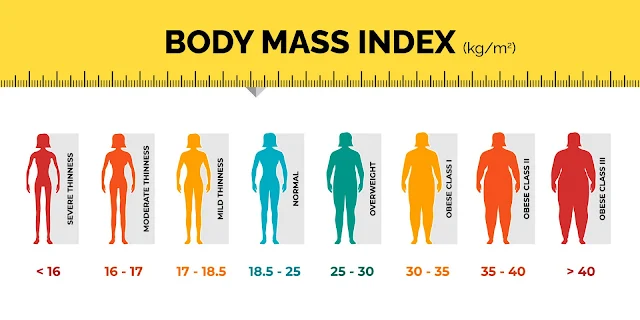Understanding BMI (Body Mass Index): A Guide with Chart
Introduction
BMI, or Body Mass Index, is a widely used tool to assess whether an individual is within a healthy weight range based on their height and weight. It is a quick and simple method to categorize individuals into weight categories such as underweight, normal weight, overweight, and obese. However, BMI doesn’t account for factors like muscle mass or fat distribution, making it a general guide rather than a definitive assessment of health.
This article will explain how BMI is calculated, provide a BMI chart for easy reference, and discuss its strengths and limitations.
What is BMI?
Body Mass Index (BMI) is a calculation that uses your weight and height to estimate if you are at a healthy weight. The formula is:
Alternatively, if using pounds and inches:
Interpreting BMI Categories
Once your BMI is calculated, it falls into one of several categories that indicate your general weight status. Here’s what these categories mean:
- Underweight: BMI less than 18.5
- Normal weight: BMI between 18.5 and 24.9
- Overweight: BMI between 25 and 29.9
- Obesity: BMI of 30 or more
Each category provides a general overview of health risks associated with different weight ranges.
BMI Chart for Adults
Use this chart to determine your BMI range based on your height and weight. The values represent your BMI status:
| BMI Range | Classification |
|---|---|
| Below 18.5 | Underweight |
| 18.5–24.9 | Normal weight |
| 25.0–29.9 | Overweight |
| 30.0 and above | Obesity |
BMI Chart by Height and Weight
For Men and Women
| Height (ft/in) | Weight (Underweight) | Weight (Normal) | Weight (Overweight) | Weight (Obese) |
|---|---|---|---|---|
| 5'0" | Below 95 lbs | 95–127 lbs | 128–153 lbs | Over 153 lbs |
| 5'2" | Below 104 lbs | 104–138 lbs | 139–164 lbs | Over 164 lbs |
| 5'4" | Below 114 lbs | 114–148 lbs | 149–174 lbs | Over 174 lbs |
| 5'6" | Below 123 lbs | 123–159 lbs | 160–185 lbs | Over 185 lbs |
| 5'8" | Below 132 lbs | 132–169 lbs | 170–197 lbs | Over 197 lbs |
| 5'10" | Below 141 lbs | 141–179 lbs | 180–208 lbs | Over 208 lbs |
| 6'0" | Below 149 lbs | 149–190 lbs | 191–220 lbs | Over 220 lbs |
| 6'2" | Below 158 lbs | 158–200 lbs | 201–232 lbs | Over 232 lbs |
| 6'4" | Below 167 lbs | 167–211 lbs | 212–244 lbs | Over 244 lbs |
How to Use the Chart:
- Find your height on the left-hand column.
- Follow that row across to your current weight to find your BMI category.
Strengths of BMI
- Simplicity: BMI is easy to calculate using basic information—height and weight.
- Widely Used: Health professionals often use BMI as a first assessment tool to gauge whether an individual might be at risk of health conditions related to weight.
- General Health Indicator: A BMI within the “normal” range generally indicates a lower risk of chronic diseases like heart disease, diabetes, and hypertension.
Limitations of BMI
While BMI is a useful tool, it has several limitations:
- Does Not Consider Muscle Mass: People with high muscle mass, such as athletes, may have a high BMI but very little body fat, leading to misleading results.
- Does Not Reflect Fat Distribution: BMI doesn’t show where fat is distributed on the body, which can be a crucial factor in assessing health risk. For instance, abdominal fat is more dangerous than fat stored in other areas.
- Age and Gender Differences: BMI calculations don't differentiate between age, sex, or ethnic backgrounds, all of which can influence the relationship between body fat and health.
- Health Status Variability: BMI alone cannot diagnose obesity or health issues. Factors like diet, activity level, and genetics are also critical to assessing an individual’s overall health.
BMI for Children and Teens
For individuals under 20 years old, BMI is interpreted differently. Children’s BMI is calculated the same way but then compared against age- and sex-specific percentiles, as body fat changes with age and varies between boys and girls. This is known as BMI-for-age.
Health Risks of Being Overweight or Obese
A BMI in the overweight or obese category can be linked to several health conditions, such as:
- Heart disease
- Type 2 diabetes
- High blood pressure
- Stroke
- Certain types of cancer
Maintaining a healthy BMI through a balanced diet and regular exercise is crucial to reducing these risks.
Conclusion
BMI is a useful screening tool for assessing weight relative to height, but it should not be the only method used to evaluate health. While it provides a good starting point, consider other factors like muscle mass, fat distribution, and overall lifestyle for a more accurate picture of your health. Always consult a healthcare professional when interpreting your BMI and discussing weight management strategies.























